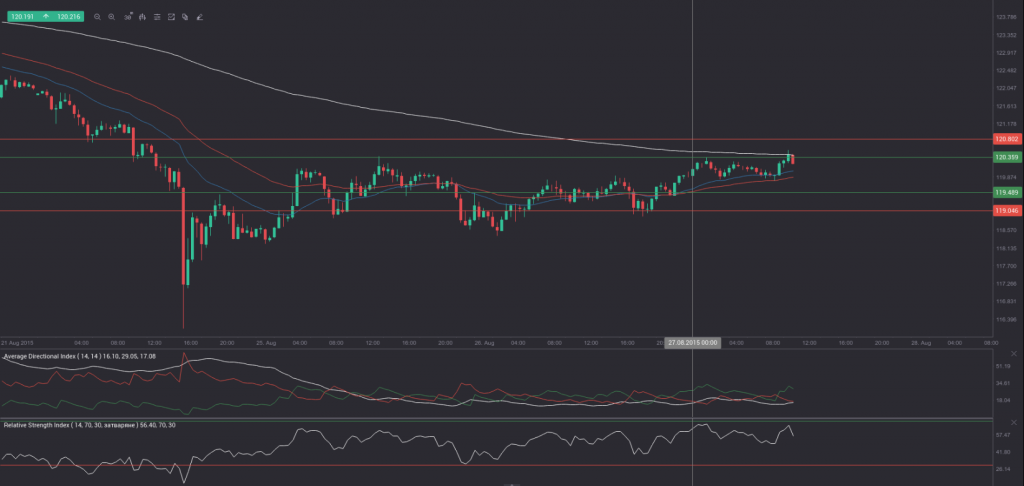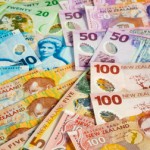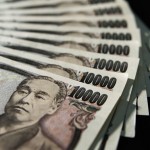Yesterday’s trade saw USD/JPY within the range of 118.43-120.03. The pair closed at 119.92, soaring 0.87% on a daily basis, while extending gains from Tuesday. The daily rate of increase has also been the sharpest one since July 10th, when the cross appreciated 1.16%.
At 7:30 GMT today USD/JPY was up 0.45% for the day to trade at 120.46. The pair touched a daily high at 120.55 at 7:41 GMT. It has been the highest level since Monday, when a daily high of 122.04 was registered.
Today the cross may be influenced by a number of macroeconomic reports as listed below.
Fundamentals
United States
Jackson Hole Symposium
The Jackson Hole Economic Policy Symposium is to commence today. Sponsored by the Federal Reserve Bank of Kansas City since 1978, the forum is attended by central bankers, policy experts, academics and financial market investors, who discuss a number of economic topics, including monetary policies.
Initial, Continuing Jobless Claims
The number of people in the United States, who filed for unemployment assistance for the first time during the business week ended on August 22nd, probably decreased to 275 000, according to market expectations, from 277 000 in the prior week. The latter has been the highest number of claims since the business week ended on July 10th, when 281 000 claims were reported.
The 4-week moving average, an indicator lacking seasonal effects, was 271 500, marking a decrease of 5 500 compared to the preceding weeks revised down average.
The business week, which ended on August 14th has been the 24th consecutive week, when jobless claims stood below the 300 000 threshold. This continues to support the case labor market conditions in the country follow the path of improvement. Claims are usually volatile during the summer period, as automakers shut assembly plants for annual retooling and also due to school vacations.
Initial jobless claims number is a short-term indicator, reflecting lay-offs in the country. In case the number of claims met expectations or dropped further, this would have a moderate bullish effect on the US dollar.
The number of continuing jobless claims probably decreased to the seasonally adjusted 2 250 000 during the business week ended on August 14th from 2 254 000 in the prior week. The latter represented a decrease by 24 000 compared to the revised up number of claims, reported in the business week ended on July 31st. This indicator reflects the actual number of people unemployed and currently receiving unemployment benefits, who filed for unemployment assistance at least two weeks ago.
The Department of Labor is to release the weekly report at 12:30 GMT.
Gross Domestic Product – second estimate
The second estimate of the US Gross Domestic Product probably pointed to an annualized rate of growth of 3.2% in the second quarter of 2015, according to the median forecast by analysts. The preliminary GDP estimate for Q2, reported on July 30th, pointed to an annual growth of 2.3%. In Q1 economy expanded at an annualized rate of 0.6%, according to final data. It was a revision up from a 0.2% contraction reported previously. The preliminary data showed that growth was supported by higher consumer spending in Q2, while business spending on equipment had a negative contribution.
Real personal consumption expenditures rose 2.9% during the second quarter, following an increase by 1.8% in Q1. Real non-residential fixed investment shrank 0.6% in Q2, after a 1.6% surge in Q1. Real exports of goods and services went up at an annualized rate of 5.3% in Q2, following a 6.0% drop during the first quarter, while real imports of goods and services rose 3.5% in Q2, after another 7.1% surge in the previous quarter. Real federal government consumption expenditures and gross investment shrank 1.1% in Q2, neutralizing the 1.1% increase during the first quarter, according to provisional data by the US Bureau of Economic Analysis.
In case the second GDP estimate outpaced expectations, this would provide a strong support to the US dollar. The revised GDP figure is due out at 12:30 GMT.
Pending Home Sales
The index of pending home sales in the United States probably rose 1.0% in July compared to June, according to the median estimate by experts. In June pending home sales unexpectedly shrank 1.8%, which has been the first monthly drop since December 2014.
In annual terms, the index of pending home sales rose 8.2% in June, or at the slowest rate since December 2014, when a climb rate of 6.1% was reported.
When a sales contract is accepted for a property, it is recorded as a pending home sale. As an indicator the index provides information on the number of future home sales, which are in the pipeline. It gathers data from real estate agents and brokers at the point of a sale and is currently the most accurate indicator regarding the US housing sector. It samples over 20% of the market. In addition, over 80% of pending house sales are converted to actual home sales within 2 or 3 months. Therefore, this index has a predictive value about actual home sales.
In case pending home sales increased more than anticipated, this would have a moderate bullish effect on the greenback. The National Association of Realtor’s (NAR) will release the official index value at 14:00 GMT.
Fed rate hike in October?
Market players have, for a while, anticipated the moment when the Federal Reserve Bank will finally raise borrowing costs following a decade-long hiatus. Most of them cited September as a possible month, when the rate hike could occur, while others bet on the December policy meeting.
However, following the recent turmoil in global markets, some analysts suggested a hike in September would probably be a premature move, while December was rather unlikely, as market liquidity tends to be thin during that period.
With three FOMC meetings on policy remaining until the end of the year, opinions appeared that a hike could be introduced in October.
Market players now see a 28% chance that the Federal Reserve Bank may raise borrowing costs at its September meeting, as they point to an average fed funds rate of 0.375% following the first hike.
There is a 37% probability that such a policy decision may occur in October, while the chance of such a move occurring in December is seen at 52%.
”We have to look at it more seriously,” said David Keeble, the head of fixed-income strategy at Credit Agricole SA in New York, cited by Bloomberg. ”You really want to be moving a little bit before December, otherwise your credibility starts to disappear.”
”An off-cycle hike in October is a possibility if September is too soon because of market jitters”, said Greg Anderson, the global head of foreign-exchange strategy at Bank of Montreal, cited by the same media.
Bond Yield Spread
The yield on Japanese 2-year government bonds went as high as 0.014% on August 26th, or the highest level since August 6th (0.014%), after which it slid to 0.009% at the close to add 0.001 percentage point on a daily basis, while marking a second consecutive trading day of gains.
The yield on US 2-year government bonds climbed as high as 0.696% on August 26th, or the highest level since August 19th (0.738%), after which it fell to 0.680% at the close to add 7.1 basis points (0.071 percentage point) for the day and marking a second straight day of gains.
The spread between 2-year US and 2-year Japanese bond yields, which reflects the flow of funds in a short term, expanded to 0.671% on August 26th from 0.601% during the prior day. The August 26th yield spread has been the most notable one since August 18th, when the difference was 0.715%.
Meanwhile, the yield on Japans 10-year government bonds soared as high as 0.389% on August 26th, or the highest level since August 17th (0.400%), after which it slid to 0.377% at the close to appreciate 0.003 percentage point compared to August 25th, while marking a second straight day of gains.
The yield on US 10-year government bonds climbed as high as 2.193% on August 26th, or the highest level since August 19th (2.230%), after which it slipped to 2.168% at the close to add 9 basis points (0.09 percentage point) on a daily basis, while marking a second consecutive day of gains.
The spread between 10-year US and 10-year Japanese bond yields expanded to 1.791% on August 26th from 1.704% during the prior day. The August 26th yield difference has been the largest one since August 18th, when the spread was 1.815%.
Daily and Weekly Pivot Levels
By employing the Camarilla calculation method, the daily pivot levels for USD/JPY are presented as follows:
R1 – 120.07
R2 – 120.21
R3 (range resistance – green on the 30-minute chart) – 120.36
R4 (range breakout – red on the 30-minute chart) – 120.80
S1 – 119.87
S2 – 119.63
S3 (range support – green on the 30-minute chart) – 119.48
S4 (range breakout – red on the 30-minute chart) – 119.04
By using the traditional method of calculation, the weekly pivot levels for USD/JPY are presented as follows:
Central Pivot Point – 122.80
R1 – 123.81
R2 – 125.58
R3 – 126.59
S1 – 121.03
S2 – 120.02
S3 – 118.25






